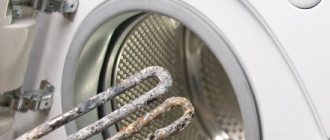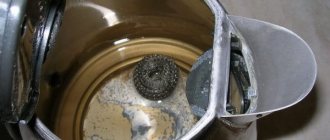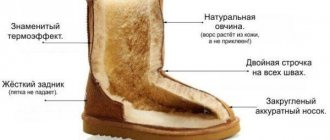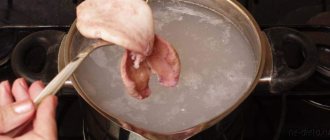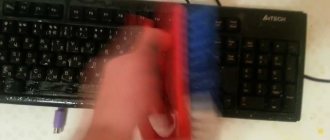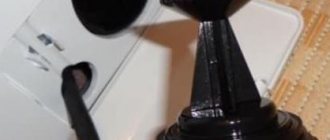It is difficult to imagine the life of a modern person without regularly washing things using an automatic machine. It significantly reduces the housewife’s work while it pleases with proper work, but can greatly ruin the mood if it refuses to perform its functions at the most inopportune moment. It happens that the machine works properly, but the washed clothes no longer seem as clean as before, and the unpleasant odor that accompanies washing becomes more intense. Can this be avoided? Our answer is yes!
How and with what to clean the washing machine from dirt and scale inside at home
If you find that instead of the aroma of freshness, your machine and washed items give off an unpleasant smell of dampness, then the equipment needs cleaning. And the sooner you take care of it, the greater the chance that the car will not break down, you will not have to replace expensive parts and spend money on calling a specialist. You can get rid of dirt, scale and unpleasant odors in different ways. To remove scale and mold, there are several fairly effective methods using improvised means that are easy to find in any kitchen.
Why do you need to clean your automatic machine?
Many people like to repeat: “We have very hard water in our region.” while in reality they do not understand exactly what they are talking about. IN
The water in city water supplies is really hard, which means it contains a lot of calcium and magnesium salts. If you wash things in it or even wash your hair without additives, both your laundry and your hair will become very rough and hard to the touch - hence the name.
If you boil such water, magnesium and calcium salts will precipitate. It is this that settles on various elements of the automatic washing machine, forming scale. The more often you wash, especially at high temperatures, the denser and thicker the scale layer will be and the faster it forms. What does this mean?
- The thicker the layer of limescale on the heating element - the heating element of the washing machine - the slower the water will heat up, since lime has low thermal conductivity.
- More electricity will be required to bring the water to the desired temperature.
- The heating element will overheat and fail faster.
That is why you should not be lazy to descale the unit in a timely manner. It will take very little effort, but the machine will last several times longer without breakdowns, and you won’t have to overpay for electricity.
How often should this procedure be performed? just look at the washing machine filter (to do this, you first need to remove it). If a grayish coating is visible on it, then it’s time for another cleaning. It is difficult to navigate by time in this case.
Those who use the machine too often should clean it once every quarter. For the rest, it is enough to do this once every 6-12 months.
Cleaning with soda
There are many special products for eliminating dirt and mold in the washing machine. If you don’t have them on hand, you can use regular soda.
Baking soda should be diluted with water in a 1:1 ratio and mixed thoroughly. Then put on rubber gloves, apply the resulting paste to a sponge and treat the contaminated surface. Then rinse the paste thoroughly and turn on the machine in rinse mode.
Cleaning with soda and citric acid
Plaque and scale form on the tank and heating element for a number of reasons:
- tap water with a lot of impurities;
- washing powders with chemical additives;
- frequent use of equipment in intensive washing mode.
Attention! Scale should be removed in a timely manner, as it can lead not only to the appearance of foreign odors, but also to damage to the heating element.
Soda in combination with citric acid will do an excellent job of removing scale that has formed on the internal surfaces. To do this, 3 teaspoons of soda and 150 g of citric acid are mixed and poured into a pre-cleaned tray for washing powder. Then you should turn on the empty machine (it is advisable to select the program with the highest temperature), and after finishing the washing mode, rinse additionally. If you are confused about turning on the machine with an empty drum, you can throw an old rag or an unnecessary towel in there.
You cannot combine cleaning and washing clothes, as this can ruin things.
Why citric acid?
Everyone knows that household appliances such as samovars and kettles are cleaned with lemon. But many housewives are afraid to clean their washing machine with it, for fear of further aggravating the situation.
- Will this substance damage the parts?
- Exactly how much lemon powder is needed.
- How often should this be done?
These and other thoughts often stop us from cleaning the machine. But, despite the fact that this method is the cheapest, it is quite simple and effective. Calling a specialist is expensive and takes a lot of time. And a lot of money is also spent on constant purchases of water softeners.
How to properly use citric acid when cleaning - video:
A product such as citric acid has a number of advantages. The most obvious is that it is harmless to humans in small quantities. It is also easily washed out of the machine, while almost all recommended products designed to protect the device from scale also remain on clothes.
Acid perfectly corrodes solid deposits, that is, scale. Therefore, it is excellent for cleaning the heating element of the machine. It will do the job on par with specialized chemicals sold in stores, since it is a class of carboxylic acids.
How can you replace citric acid?
In addition to this method, there are other ways to clean the washing machine from sediment:
- "Antiscale". A preparation containing special acids that dissolve scale crusts. Placed in the empty cavity of the drum, the washing mode starts. A prerequisite is compliance with the strict dosage indicated in the instructions.
- Vinegar and whiteness. To clean, you need to pour two glasses of concentrated liquid and turn on the program with maximum temperature for 5 minutes. Then pause for 1 hour to soak. Processing must be completed using the short mode.
- Soda. The powder, like citric acid, is effective in removing plaque and mold growth. It is poured into the compartment and processed during a long program. High temperature is required for best effect. After finishing the program, you should wipe the inside of the drum and rubber seals from plaque.
- Magnetic filters for drums. They prevent the appearance of plaque in the unit - an effective assistant in getting rid of the harmful salt component. Long service life, but much higher cost.
Frequency of application
The frequency of cleaning the washing machine depends on the condition of the unit, the frequency of its use and the composition of the water used. An old car, which is used almost daily, needs preventive cleaning of dirt and limescale at least once every 3 months. If there are no obvious signs of deposit accumulation, then every 3 months you need to clean the mechanisms with hot water, running the machine for an idle wash. However, this must be done every 6 months using acid.
When assessing the frequency of use, the appropriateness and consequences of the actions should be taken into account. A fully cleaned machine can be used without problems for about a year. However, it is necessary to constantly check the condition of its most vulnerable components and parts.
From a safety point of view, you can clean your washing machine with citric acid at least every month. There will be no great harm from these actions if you do not use other cleansers.
Thus, the home method of cleaning a car using citric acid allows for preventive cleaning once every 6 months. If it is necessary to remove accumulated contaminants that threaten the operation of the machine, the product can be used regularly once every 3 months. More frequent use of acid may be dictated by extreme necessity. However, long-term use of the product once a month or more often is unacceptable. In this case, wear on the most vulnerable and important parts increases.
Cleaning with vinegar
9 percent vinegar will help in the fight against mold and mildew. 2 glasses of vinegar are poured into the liquid detergent compartment, then the machine is turned on, selecting a high-temperature wash mode for 10-15 minutes. Then you should pause the machine and leave it for several hours so that the vinegar solution acts on the scale and eliminates harmful microorganisms. Then the washing is resumed, and at the end of the procedure, the machine is put on an additional rinse.
Using a vinegar solution, you can also treat the rubber seal of the hatch, carefully pull the rubber, remove all debris from the folds, and then wipe with a dry cloth. After cleaning, it is better to leave the door open for a while so that the drum dries out and the damp smell does not reappear. Many housewives add a little vinegar during the washing process to prevent scale formation. It softens the water a little.
How to properly clean a washing machine with citric acid
All you need for this procedure is citric acid and a clean, soft cloth, which you will use to wipe the washing machine after finishing cleaning. Next we proceed like this:
- Remove all dirty items from the drum and remove powder or conditioner from the tray. To properly clean the internal parts of the unit, you need to wash at idle speed. Then the laundry will not be damaged, and the scale will be effectively removed the first time.
- Pour citric acid into the washing powder tray - you will need 100 g of it for a small-volume machine, and 150 for a larger one. If you have acid in bags, then for one cleaning you will need 3-4 bags, depending on how many grams of powder it contains.
- The water temperature is set to 90 degrees and no less. The longest washing cycle should be selected.
- If the machine has not been cleaned for a long time, then you can do this: when the drum is filled with water and it warms up, press pause and leave the machine for half an hour. Then the acid is guaranteed to dissolve even the densest deposits of calcium and magnesium salts. Then remove the pause and continue the normal washing cycle.
- If you have any doubts that the rinsing has removed all the scale particles, you can turn on an additional rinse.
After the machine finishes washing and turns off, open the drum and use a soft cloth to wipe dry all accessible parts and surfaces. Be sure to peel back the edges of the rubber seal and wipe it thoroughly. Firstly, pieces of lime may remain in the fold, and secondly, contact with acid causes the rubber to become hard and may tear.
Therefore, after each cleaning with citric acid, do not forget to wipe the seal dry, otherwise the unit cover will very soon lose its seal.
If you have already started cleaning your washing machine, it won’t hurt to remove the filter and clean it too. There are probably some scale particles stuck in it, which should be removed immediately. That's all. Now your automatic washing machine shines and smells nice, you can continue to use it.
Composition for removing old scale
If you have never carried out preventative cleaning of your washing machine from scale and dirt, and also do not use special water softening products, we recommend that you carry out a more intensive cleaning for the first time, combining the advantages of all of the above products.
You will need:
- 1 cup (200 ml) 9% vinegar
- 1 tbsp. l. baking soda
- 1 tbsp. l. citric acid
Cleaning method:
Prepare the solution by mixing 1 tbsp. spoon of citric acid with 1 tbsp. spoon of baking soda and 100 ml of water. Pour this mixture into the compartment for liquid powder or conditioner. Pour 1 cup of 9% vinegar into the drum of the washing machine.
Select the longest wash cycle at maximum temperature and start the machine. After 20-25 minutes, press pause and let the machine stand with this solution for 1 hour. Then finish the wash cycle.
After the end of the program, he recommends wiping the rubber parts and the door with a weak solution of vinegar (as in the previous method) and running the machine on the shortest wash cycle.
The procedure for cleaning the heating element of the machine from scale should be carried out once every two months. However, the process of cleaning a washing machine using citric acid should be done with caution. If used too often, acid can destroy not only limescale, but also the rubber parts of the washing machine. In this case, the rubber will become hard and will most likely allow water to pass through.
Instructions for use
Citric acid can be used to clean the washing machine both inside and outside. Let's consider each method of application in more detail.
Cleaning inside
To clean the inside of the washing machine from mucus, plaque, lime deposits and other contaminants, you need to use citric acid once every two months. The same remedy is also relevant if an unpleasant odor appears inside the device. During the cleaning process, the washing machine drum should be empty, without laundry. If you have never cleaned the device before, or more than 6 months have passed since the last procedure, take the maximum amount of powder (150–200 g for machines with a load of 5 kg or more, 100 g for machines with a load of 3–4 kg).
It is recommended to turn off the spin mode, if possible, since it is not necessary; the machine will waste electricity. The wash cycle should end with the water draining.
So, to carry out routine internal cleaning of your washing machine, proceed as follows:
- Make sure there is no clothing in the drum.
- Place citric acid in the detergent compartment (70 g for machines with a load of 3-4 kg, 100 g for machines with a load of 5 kg).
- Set the cotton washing mode to 60 degrees (if heavily soiled - 90 degrees), including rinsing.
- At the end of the wash, open the door and inspect the rubber seals for deposits of scale and undissolved citric acid. If found, remove them and wipe the surface with a cloth.
Citric acid can also be poured directly into the drum, but then the detergent compartment will not be cleanable.
Cleaning outside
Citric acid can also be used to clean external parts of the structure from dirt and dust. A weakly concentrated solution is suitable for this. Proceed as follows:
- Pour 3–4 liters of warm water into a basin.
- Add 20 g of citric acid.
- Stir until the crystals are completely dissolved.
- Take a cotton cloth or microfiber cloth and soak it in the solution.
- Wipe the outside of the washing machine, as well as the rubber seals on the drum and the detergent compartment.
- Wipe the surface dry with a cloth (no rinsing required).
Useful tips
To achieve optimal results and take care of your assistant without harming her, it is important to consider the following nuances:
- The water temperature should not exceed 90 degrees . Otherwise, the chemical effect on the rubber and metal parts of the device may be too intense and lead to their damage. To prevent scale, a sufficient temperature is considered to be 60 degrees. For severe contamination, a single “run” with citric acid at a temperature of 90 degrees is permissible.
- Use no more than 200 g of crystals. 100 g is enough to dissolve up to 80 g of limescale during routine cleaning. In case of heavy contamination, the quantity can be increased, but not more than 200 g. Otherwise, there is a risk of harming the internal parts of the device.
- Only powdered citric acid is suitable for cleaning; it cannot be replaced with lemon juice or other similar products, since the concentration of the active substance is insufficient.
Do not leave the house during a wash cycle with citric acid; the drain hole may become clogged with large scale fragments. If you do not remove them in a timely manner, the device may leak or malfunction. If you hear an unusual noise, whistling or grinding noise while draining water, press the pause button to pause the device. Check the drain hole for blockages. You may need to wait until the door is unlocked and check for foreign pieces in the laundry compartment. After cleaning the machine with citric acid, inspect the special compartment for small parts (usually at the bottom on the facade of the device), clean it with a sponge, brush or brush.
Cleaning with bleach
Chlorine helps fight mold and is often used to disinfect washing equipment. To do this, pour half a glass of white into the drum, turn on a high-temperature washing program and wash for about 40 minutes. After this, an additional rinse will be required.
Whiteness should not be overused: you should use it to clean your washing machine no more than twice a year.
How to clean
So, the washing machine is prepared for this important event, and so is the citric acid. What to do next, how to clean the washing machine without the risk of damage to its parts?
- First, citric acid is added in the specified amount. You can pour it instead of powder, into a special tray, or directly into the drum. Experts and simply experienced users recommend pouring the products into the tray - then citric acid will pass through all the parts and elements of the washing machine, destroying limescale and mold along the way. And the tray itself, on which solid deposits of washing powder often accumulate, should be cleaned. You can wash it separately, but this is faster and easier.
- Set any washing program, the main thing is that the water temperature is at least 60 degrees. If your machine has never been cleaned at all, you can set the temperature to the highest possible - usually 90 degrees. It doesn’t matter what mode is chosen - cotton, boiling or any other. The main thing is that the program is complete, that is, it includes soaking, rinsing, and spinning.
- You don't need to do anything else. The machine will work, wash and clean itself of limescale deposits and other accumulated debris. If your unit is not connected directly to the sewer, you can see for yourself what water will drain after the first stage of washing, and what water will drain at the end, after spinning.
You may want to turn your washing machine back on to the rinse cycle after you've finished cleaning it. This will not harm - then you can be sure that any debris and pieces of lime will be washed out of its parts.
Don’t forget to open the door when finished and wipe the rubber gasket and drum dry again. Do not close it again immediately - let it air out and dry completely. It is recommended to leave the washing machine open overnight.
How to clean a washing machine with citric acid from scale, odor and mold: instructions
To get rid of known plaque, unpleasant odors and mold, it is recommended to proceed as follows:
- Pour the prepared product into the powder dispenser (main wash compartment).
- Select a program that allows washing at maximum temperature.
- Then activate the extra rinse mode.
- At the end of the procedure, the plastic powder dispenser should be rinsed under running water (if it is removable) or wiped with a damp and then dry cloth.
- It is also recommended to wipe the drum dry with a soft cloth and check the cuff of the machine for scale and cleaning agent residues.
After the process of cleaning the washer with citric acid is completed, the device can be immediately used for its intended purpose.
Pros and cons of using citric acid
Citric acid has the following benefits:
- Safe for health. During the process of chemical reaction, dissolution of salts and boiling, calcium citrates are formed. They are safe, so if, after cleaning, product residue accidentally gets on things, it will not cause allergies or deterioration in health.
- Low cost.
- Availability - can be purchased at any store - grocery or household chemicals.
- You don’t need a lot of knowledge, skills and experience to carry out the cleaning procedure.
- High efficiency.
- No unpleasant odor.
Despite rumors about the negative impact of acid on the parts of the unit, experts came to the conclusion that this is due to an incorrect procedure or substitution of concepts (in industry they often use hydrochloric acid, but you cannot clean the machine with it, it is more aggressive).
Popular myths about the dangers of lemongrass:
- Limescale after cleaning can clog the pipe. This is an unlikely fact, since the dissolution process occurs slowly, crushing the salts into small particles.
- The seal cuffs may crack as they soften. This is not true, since the concentration of acid is not enough to soften the rubber. The problem can only arise if after the procedure you do not remove the residue from the rubber seal with a dry cloth.
- Corrodes metal parts. False: The amount of lemon juice used in cleaning does not act as aggressively. You need a more concentrated product and an amount 20-30 times larger.
The full cycle procedure is recommended for use by specialists in the repair of automatic washing machines as a preventative measure for the formation of scale on machine parts.
Top best ready-made cleansers
The deposits that form on them pose a huge danger to the internal parts of your unit. Companies involved in the production of washing machines recommend using special preparations to clean the drum, heating element and other parts of the machine. The cleaning ability of these products is based on the presence of a strong acid in their composition. Therefore, they should be used only when a white coating appears.
Typically, cleaning is carried out twice a year. The products used during this procedure have different consistencies. They are available in the form of powder, tablets or gel. Before using any of the products, you must carefully read the instructions and act in accordance with the manufacturer's recommendations.
We list the most effective drugs that help clean the washing machine from dirt and scale.
Magic Power
It fights well against complex types of scale that have accumulated on the drum and heating element due to prolonged use of the unit. Country of origin: Germany. It is considered one of the most effective remedies. Particularly suitable for use in regions where the water contains various salts, impurities and has a high level of hardness. The drug contains citric acid.
- It is enough to apply once every 6 months.
- High efficiency.
- Comfortable to use.
- The product contains no aggressive chemical elements and is non-toxic.
Topper
Leading washing machine manufacturers – Bosch and Miele – developed this product jointly for their products. The drug quickly copes with even very large deposits of scale on the heating element and filter. It is recommended to apply Topper three times a year. One package, weighing 125 grams, is enough for one procedure - the powder is poured into the drum and a “idle” wash is started. The water temperature must be at least 60°C.
- Complex impact.
- Removes dirt well.
- Dissolves salt deposits formed on the heating element.
- Affordable price.
- You can fix the problem with one cleaning.
- Ease of use.
- There is no pungent odor after use.
- Suitable for dishwasher cleaning.
Top House
Quite an effective product that perfectly removes dirt and scale from parts of the washing machine. One bottle contains 500 ml of product. This makes it possible to carry out up to five cleanings per year.
- The product is quite economical.
- Ease of use.
Rules of procedure
How to clean a washing machine with citric acid? The procedure is performed according to the following algorithm:
- First, a device check is required. All forgotten things must be removed from it. The rubber cuff must be pulled back a little and thoroughly wiped with an absorbent cloth to remove any remaining moisture and dirt.
- Where is the product added? It must be placed in the compartment intended for washing powder.
- Then you need to turn on the device and select a program that includes rinsing and spinning, which eliminates any remaining product. A suitable temperature is 60 degrees: at these temperatures, plaque dissolves. But if the device has not been cleaned for a long time, the water hardness is greatly increased, and there is a lot of scale, then the procedure must be performed at high temperatures - 90-95 degrees. But in this case, there is no need to choose a long program so that the elements of the equipment are not damaged.
- Then you need to close and turn on the machine. There is no need to load the drum; it must be empty.
- After completing the process, you need to open the machine, wipe and wash the inside if there are particles of removed scale. You should also remove the rubber cuff and inspect it to remove any remaining dirt.
- The equipment must be open until dry. The powder compartment must be dried.
This is how we descale any type of washing machine with citric acid. A correctly performed procedure will improve the performance of the equipment. Cleaning the washing machine drum with citric acid can be done 2-3 times a year. If the device is actively used, then the procedure should be carried out every 25-30 washes, especially with hard tap water, processing woolen or fleecy products, the particles of which contaminate the machine.
This procedure is performed when scale is considered the main problem. During a “idle” wash, citric acid comes into contact with other parts of the appliance and removes plaque. If you know how to clean a washing machine with citric acid, the appliance will last longer.


